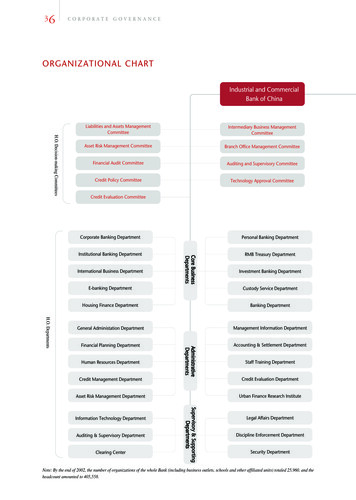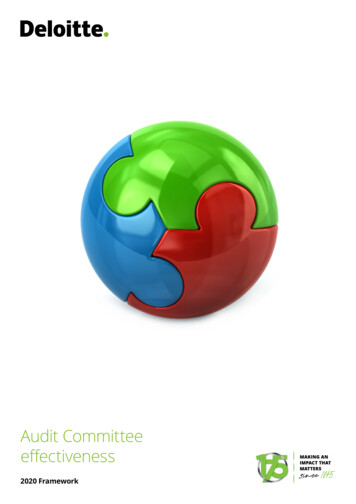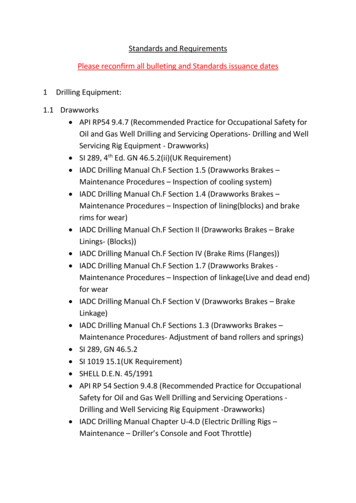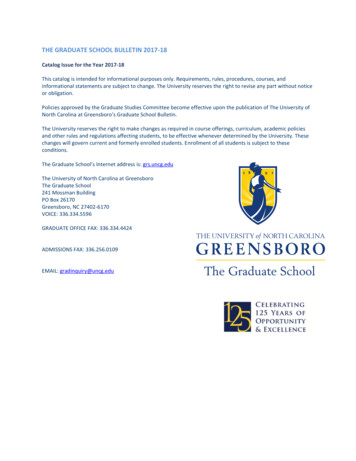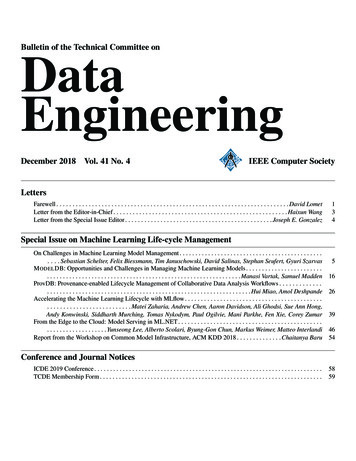
Transcription
Bulletin of the Technical Committee onDataEngineeringDecember 2018Vol. 41 No. 4IEEE Computer SocietyLettersFarewell . . . . . . . . . . . . . . . . . . . . . . . . . . . . . . . . . . . . . . . . . . . . . . . . . . . . . . . . . . . . . . . . . . . . . . . . David LometLetter from the Editor-in-Chief . . . . . . . . . . . . . . . . . . . . . . . . . . . . . . . . . . . . . . . . . . . . . . . . . . . . . . Haixun WangLetter from the Special Issue Editor . . . . . . . . . . . . . . . . . . . . . . . . . . . . . . . . . . . . . . . . . . . . . . Joseph E. Gonzalez134Special Issue on Machine Learning Life-cycle ManagementOn Challenges in Machine Learning Model Management . . . . . . . . . . . . . . . . . . . . . . . . . . . . . . . . . . . . . . . . . . . . . . . . Sebastian Schelter, Felix Biessmann, Tim Januschowski, David Salinas, Stephan Seufert, Gyuri SzarvasM ODEL DB: Opportunities and Challenges in Managing Machine Learning Models . . . . . . . . . . . . . . . . . . . . . . . . . . . . . . . . . . . . . . . . . . . . . . . . . . . . . . . . . . . . . . . . . . . . . . . . . . . . . . . . . . . . Manasi Vartak, Samuel MaddenProvDB: Provenance-enabled Lifecycle Management of Collaborative Data Analysis Workflows . . . . . . . . . . . . . . . . . . . . . . . . . . . . . . . . . . . . . . . . . . . . . . . . . . . . . . . . . . . . . . . . . . . . . . . . . . . . Hui Miao, Amol DeshpandeAccelerating the Machine Learning Lifecycle with MLflow . . . . . . . . . . . . . . . . . . . . . . . . . . . . . . . . . . . . . . . . . . . . . . . . . . . . . . . . . . . . . . . . . . . . Matei Zaharia, Andrew Chen, Aaron Davidson, Ali Ghodsi, Sue Ann Hong,Andy Konwinski, Siddharth Murching, Tomas Nykodym, Paul Ogilvie, Mani Parkhe, Fen Xie, Corey ZumarFrom the Edge to the Cloud: Model Serving in ML.NET . . . . . . . . . . . . . . . . . . . . . . . . . . . . . . . . . . . . . . . . . . . . . . . . . . . . . . . . . . . . . . . Yunseong Lee, Alberto Scolari, Byung-Gon Chun, Markus Weimer, Matteo InterlandiReport from the Workshop on Common Model Infrastructure, ACM KDD 2018 . . . . . . . . . . . . . . Chaitanya Baru51626394654Conference and Journal NoticesICDE 2019 Conference . . . . . . . . . . . . . . . . . . . . . . . . . . . . . . . . . . . . . . . . . . . . . . . . . . . . . . . . . . . . . . . . . . . . . . . .TCDE Membership Form . . . . . . . . . . . . . . . . . . . . . . . . . . . . . . . . . . . . . . . . . . . . . . . . . . . . . . . . . . . . . . . . . . . . . .5859
Editorial BoardTCDE Executive CommitteeEditor-in-ChiefHaixun WangWeWork Corporation115 W. 18th St.New York, NY 10011, USAhaixun.wang@wework.comAssociate EditorsPhilippe BonnetDepartment of Computer ScienceIT University of Copenhagen2300 Copenhagen, DenmarkChairXiaofang ZhouThe University of QueenslandBrisbane, QLD 4072, Australiazxf@itee.uq.edu.auExecutive Vice-ChairMasaru KitsuregawaThe University of TokyoTokyo, JapanSecretary/TreasurerThomas RisseL3S Research CenterHanover, GermanyJoseph GonzalezEECS at UC Berkeley773 Soda Hall, MC-1776Berkeley, CA 94720-1776Committee MembersAmr El AbbadiUniversity of CaliforniaSanta Barbara, California 93106Guoliang LiDepartment of Computer ScienceTsinghua UniversityBeijing, ChinaMalu CastellanosTeradataSanta Clara, CA 95054Alexandra MeliouCollege of Information & Computer SciencesUniversity of MassachusettsAmherst, MA 01003Xiaoyong DuRenmin University of ChinaBeijing 100872, ChinaDistributionBrookes LittleIEEE Computer Society10662 Los Vaqueros CircleLos Alamitos, CA 90720eblittle@computer.orgWookey LeeInha UniversityInchon, KoreaRenée J. MillerUniversity of TorontoToronto ON M5S 2E4, CanadaThe TC on Data EngineeringMembership in the TC on Data Engineering is open toall current members of the IEEE Computer Society whoare interested in database systems. The TCDE web page ishttp://tab.computer.org/tcde/index.html.Erich NeuholdUniversity of ViennaA 1080 Vienna, AustriaKyu-Young WhangComputer Science Dept., KAISTDaejeon 305-701, KoreaThe Data Engineering BulletinThe Bulletin of the Technical Committee on Data Engineering is published quarterly and is distributed to all TCmembers. Its scope includes the design, implementation,modelling, theory and application of database systems andtheir technology.Letters, conference information, and news should be sentto the Editor-in-Chief. Papers for each issue are solicitedby and should be sent to the Associate Editor responsiblefor the issue.Opinions expressed in contributions are those of the authors and do not necessarily reflect the positions of the TCon Data Engineering, the IEEE Computer Society, or theauthors’ organizations.The Data Engineering Bulletin web site is athttp://tab.computer.org/tcde/bull about.html.Liaison to SIGMOD and VLDBIhab IlyasUniversity of WaterlooWaterloo, Canada N2L3G1i
FarewellIt was way back in 1992 that Rakesh Agrawal, then the TCDE Chair, appointed me as Editor-in-Chief of theData Engineering Bulletin. At the time, I saw it as a great opportunity. But it did not occur to me that it wouldbecome such an enormous part of my career. Now, 26 years later, it is time, perhaps past time, for me to passthis position on to younger hands, in this case to the capable hands of Haixun Wang. It should not come as asurprise that I am stepping down. Rather, the surprise should be “why did I stay so long?” This message is acombination of answer to that question and historical sketch of my time as EIC. These are not unrelated.When I first became EIC, the Bulletin had already established a reputation as an industry and engineeringfocused publication, each issue of which was on a special topic. Won Kim, my predecessor, had very capablyestablished that publication model. Papers are solicited by each issue editor, with the editor selecting whichauthors to invite. The papers are a mix of work in progress, position statements, surveys, etc. But all focusedon the special topic. I was determined not to screw this up. Indeed, I accepted the EIC appointment because Ibelieved that the role that the Bulletin played is unique in our database community. I stayed so long because Istill believe that.Over the years, the Bulletin went through several major changes. As early as 1993, the Bulletin could beaccessed online as well as via print subscription. This was a major transition. Mark Tuttle, then a colleagueof mine in Digital (DEC) Cambridge Research Lab designed the latex style files that enabled this. Shortlythereafter, to economize on costs, the Bulletin became one of the earliest all electronic publications in our field.In 1995, hosting the Bulletin web site was provided by Microsoft- continuing until three years ago. Around2010, the IEEE Computer Society became the primary host for the Bulletin. Around 2000, at the suggestion(prodding) of Toby Lehman,individual articles in addition to complete issues were served from the Bulletin websites. Over this time, the style files and my procedures for generating the Bulletin evolved as well. Mark Tuttleagain, and S. Sudarshan, who had been a Bulletin editor, provided help in evolving procedures used to generatethe Bulletin and its individual articles.The Computer Society, and specifically staff members John Daniel, Carrie Clark Walsh, and Brookes Little,provided a TCDE email membership list used to distribute issue announcements, as well as helping in myriadother ways. The existence of dbworld (one of Raghu Ramakrishnan enduring contributions) enabled wider announcement distribution to our database community. The cooperation of Michael Ley with the prompt indexingof the Bulletin at dblp both ensured wider readership and provided an incentive for authors to contribute. Overthe years, I was given great support by TCDE Chairs, starting with Rakesh Agrawal, then Betty Salzberg, ErichNeuhold, Paul Larson, Kyu-Young Whang, and Xiaofang Zhou.The most important part of being Bulletin EIC was the chance to work with truly distinguished members ofthe database community. It was enormously gratifying to have stars of our field (including eight Codd Awardwinners- so far) serving as editors. I take pride in appointing several of them as editors prior to their widerrecognition. It is the editors that deserve the credit for producing, over the years, a treasure trove of specialissues on technologies that are central to our data engineering field. Superlative editors, and their success inrecruiting outstanding authors, is the most important part of the Bulletin’s success. Successfully convincingthem to serve as editors is my greatest source of pride in the role I played as Bulletin EIC.Now I am happy to welcome Haixun to this wonderful opportunity. Haixun’s background includes outstanding successes in both research and industry. He recently served ably as a Bulletin associate editor for issues on“Text, Knowledge and Database” and “Graph Data Processing”. His background and prior editorial experiencewill serve our data engineering community well and ensure the ongoing success of the Bulletin. I wish him andthe Bulletin all the best.And so “farewell”. I will always treasure having served as Bulletin EIC for so many years. It was a rareprivilege that few are given. Knowing that we were reaching you with articles that you found valuable is what1
has made the effort so rewarding to me personally. Thank you all for being loyal readers of the Bulletin.David LometMicrosoft Corporation2
Letter from the Editor-in-ChiefThank You, David!I know I represent the readers, the associate editors, and also the broad database community when I say we areextremely grateful to David Lomet for his distinguished and dedicated service as the Editor-in-Chief of the DataEngineering Bulletin for the last 26 years.Since its launch in 1977, the Bulletin has produced a total of 154 issues. Reading through the topics of thepast issues that spanned more than four decades makes me feel nothing short of amazing. They show not justhow far the database research has come, but to a certain extent, how much the entire field of computer scienceand the IT industry have evolved. While important topics never fail to arise in the Bulletin in a timely fashion, itis also interesting to observe in the 154 issues many recurring topics, including query optimization, spatial andtemporal data management, data integration, etc. It proves that the database research has a solid foundation thatsupports many new applications, and at the same time, it demonstrates that the database research is constantlyreinventing itself to meet the challenges of the time. What the Bulletin has faithfully documented over the last42 years is nothing else but this amazing effort.Among the 154 issues since the launch of the Bulletin, David had been the Editor-in-Chief for 103 of them.This itself is a phenomenal record worth an extra-special celebration. But more importantly, David shaped thediscussions and the topics in the long history of the Bulletin. I had the honor to work with David in 2016 and2017 when I served as the associate editor for two Bulletin issues. What was most appealing to me was theopportunity of working with the top experts on a topic that I am passionate about. The Bulletin is truly uniquein this aspect.I understand the responsibility and the expectation of the Editor-in-Chief, especially after David set such agreat example in the last 26 years. I thank David and the associate editors for their trust, and I look forwardto working with authors, readers, and the database community on the future issues of the Data EngineeringBulletin.The Current IssueMachine learning is changing the world. From time to time, we are amazed at what a few dozen lines of pythoncode can achieve (e.g., using PyTorch, we can create a simple GAN in under 50 lines of code). However, formany real-life machine learning tasks, the challenges lie beyond the dozen lines of code that construct a neuralnetwork architecture. For example, hyperparameter tuning is still considered a “dark art,” and having a platformthat supports parallel tuning is important for training a model effectively and efficiently. Model training is justone component in the life cycle of creating a machine learning solution. Every component, ranging from datapreprocessing to inferencing, requires just as much support on the system and infrastructure level.Joseph Gonzalez put together an exciting issue on the life cycle of machine learning. The papers he selectedfocus on systems that help manage the process of machine learning or resources used in machine learning.They highlight the importance of building such supporting systems, especially for production machine learningplatforms.Haixun WangWeWork Corporation3
Letter from the Special Issue EditorMachine learning is rapidly maturing into an engineering discipline at the center of a growing range of applications. This widespread adoption of machine learning techniques presents new challenges around the management of the data, code, models, and their relationship throughout the machine learning life-cycle. In this specialissue, we have solicited work from both academic and industrial leaders who are exploring how data engineeringtechniques can be used to address the challenges of the machine learning life-cycle.TrainingModel DevelopmentDataCollectionInferencePrediction ServiceCleaning g &ValidationTrainedModelsTraining PipelinesFeature Eng. &Model DesignLiveDataValidationPredictionEnd UserApplicationFeedbackFigure 1: Machine Learning Life-cycle. A simplified depiction of the key stages of a machine learning application.The machine learning life-cycle (Fig. 1) spans not only the model development but also production trainingand inference. Each stage demands different skills (e.g., neural network design, data management, and clustermanagement) and imposes different requirements on the underlying systems. Yet there is an overwhelming needfor unifying design principles and technologies to address pervasive problems including feature management,data provenance, pipeline reproducibility, low-latency serving, and prediction monitoring just to name a few.There has been a flurry of recent progress in systems to aid in managing the machine learning life-cycle.Large industrial projects like FB Learner Flow from Facebook, Michelangelo from Uber, and TFX from Googlehave received considerable recent attention. In this issue, we have solicited papers from several recent industrialand academic projects that have received slightly less attention.The first paper provides an overview of several real-world use cases and then outlines the key conceptual,data management, and engineering challenges faced in production machine learning systems. The second andthird papers explores the challenges of model management and provenance across the machine learning lifecycle. They motivate the need for systems to track models and their meta-data to improve reproducibility,collaboration, and governance. The second paper introduces, ModelDB, an open-source system for model management and describe some of the functionality and design decisions. The third paper describes a related system,ProvDB, that uses a graph data model to capture and query fine-grained versioned lineage of data, scripts, andartifacts throughout the data analysis process. The fourth paper describes, MLFlow, a new open-source systemto address the challenges of experimentation, reproducibility, and deployment. This work leverages containerization to capture the model development environment and a simple tracking API to enable experiment tracking.The fifth paper focuses on inference and explores the challenges and opportunities of serving white-box prediction pipelines. Finally, we solicited a summary of the recent Common Modeling Infrastructure (CMI) workshopat KDD 2018, which provides a summary of the keynotes and contributed talks.The work covered here is only a small sample of the emerging space of machine learning life-cycle management systems. We anticipate that this will be a growing area of interest for the data engineering community.Joseph E. GonzalezUniversity of California at BerkeleyBerkeley, CA4
On Challenges in Machine Learning Model ManagementSebastian Schelter, Felix Biessmann, Tim Januschowski,David Salinas, Stephan Seufert, Gyuri asg }@amazon.comAmazon ResearchAbstractThe training, maintenance, deployment, monitoring, organization and documentation of machine learning (ML) models – in short model management – is a critical task in virtually all production ML usecases. Wrong model management decisions can lead to poor performance of a ML system and can resultin high maintenance cost. As both research on infrastructure as well as on algorithms is quickly evolving,there is a lack of understanding of challenges and best practices for ML model management. Therefore,this field is receiving increased attention in recent years, both from the data management as well asfrom the ML community. In this paper, we discuss a selection of ML use cases, develop an overviewover conceptual, engineering, and data-processing related challenges arising in the management of thecorresponding ML models, and point out future research directions.1IntroductionSoftware systems that learn from data are being deployed in increasing numbers in industrial application scenarios. Managing these machine learning (ML) systems and the models which they apply imposes additionalchallenges beyond those of traditional software systems [18, 26, 10]. In contrast to textbook ML scenarios (e.g.,building a classifier over a single table input dataset), real-world ML applications are often much more complex,e.g., they require feature generation from multiple input sources, may build ensembles from different models,and frequently target hard-to-optimize business metrics. Many of the resulting challenges caught the interest ofthe data management research community only recently, e.g., the efficient serving of ML models, the validationof ML models, or machine learning-specific problems in data integration. A major issue is that the behaviorof ML systems depends on the data ingested, which can change due to different user behavior, errors in upstream data pipelines, or adversarial attacks to name just some examples [3]. As a consequence, algorithmic andsystem-specific challenges can often not be disentangled in complex ML applications. Many decisions for designing systems that manage ML models require a deep understanding of ML algorithms and the consequencesfor the corresponding system. For instance, it can be difficult to appreciate the effort of turning raw data frommultiple sources into a numerical format that can be consumed by specific ML models – yet this is one of themost tedious and time consuming tasks in the context of ML systems [32].In this paper, we introduce a set of intricate use cases in Section 2, and elaborate on the correspondinggeneral challenges with respect to model management. We discuss conceptual challenges in Section 3.1, e.g.,Copyright 2018 IEEE. Personal use of this material is permitted. However, permission to reprint/republish this material foradvertising or promotional purposes or for creating new collective works for resale or redistribution to servers or lists, or to reuse anycopyrighted component of this work in other works must be obtained from the IEEE.Bulletin of the IEEE Computer Society Technical Committee on Data Engineering5
how to exactly define the model to manage [35], how to validate the predictions of a model both before and afterdeployment [3], and how to decide when to retrain a model. Next, we elaborate on data-management relatedchallenges in Section 3.2. These evolve around the fact that ML models are part of larger ML pipelines, whichcontain the corresponding feature transformations and related metadata [31, 34]. Efficient model managementrequires us to be able to capture and query the semantics, metadata and lineage of such pipelines [37, 27, 36].Unfortunately, this turns out to be a tough problem as there is no declarative abstraction for ML pipelines thatapplies to all ML scenarios. Finally, we list a set of engineering-related challenges, which originate from a lackof agreed-upon best practices as well as from the difficulties of building complex systems based on componentsin different programming languages (Section 3.3).2Selected Use CasesTime Series Forecasting. Large-scale time series prediction or forecasting problems have received attentionfrom the ML, statistics and econometrics community. The problem of forecasting the future values of a timeseries arises in numerous scientific fields and commercial applications. In retail, an accurate forecast of productdemand can result in significant cost reductions through optimal inventory management and allocation. In modern applications, many time series need to be forecasted for simultaneously. Classical forecasting techniques,such as ARIMA models [7], or exponential smoothing and its state-space formulation [14] train a single modelper time series. Since these approaches are typically fast to train [33, 15], it is possible to retrain the modelsevery time a new forecast needs to be generated. In theory, this would mean that little to no management ofthe resulting models is required; however, the practice very often differs significantly. While classical forecasting models excel when time series are well-behaved (e.g., when they are regular, have sufficiently long history,are non-sparse), they struggle with many characteristics commonly encountered in real-world use cases such ascold-starts (new products), intermittent time series and short life cycles [30]. Such complications require modelsthat can transfer information across time series. Even for well-behaved time series, we may often want to beable to learn certain effects (e.g., the promotional uplift in sales) across a number of products. Therefore, forecasting systems in the real-world become quite complex even if the classical models at its core are simple [6].Maintaining, managing, and improving the required ML pipelines in such systems is a non-trivial challenge –not only in production environments which may require complex ensembles of many simple models, but especially in experimental settings when different individual models are evaluated on different time series. We foundthat a natural alternative to such complex ensembles of simple models is end-to-end learning via deep learningmodels for forecasting [11]. Neural forecasting models have the ability to learn complex patterns across timeseries. They make use of rich metadata without requiring significant manual feature engineering effort [13],and therefore generalize well to different forecasting use cases. Modern, general-purpose implementations ofneural forecasting mdoels are available in cloud ML services such as AWS SageMaker [17]. However, whensuch neural forecasting models are deployed in long-running applications, careful management of the resultingmodels is still a major challenge, e.g., in order to maintain backwards compatibility of the produced models.Missing Value Imputation. Very often, ML is leveraged to automatically fix data quality problems. A prominent issue in this context are missing values. A scenario in which missing values are problematic are productcatalogs of online retailers. Product data needs to be complete and accurate, otherwise products would not befound by customers. Yet in many cases, product attributes may not be entered by sellers, or they might applya different schema and semantic, which results in conflicting data that would need to be discarded. Manuallycurating this data does not scale, hence automatic solutions leveraging ML technology are a promising optionfor ensuring high data quality standards. While there are many approaches dealing with missing values, mostof these methods are designed for matrices only. In many real-world use cases however, data is not available innumeric formats but rather in text form, as categorical or boolean values, or even as images. Hence most datasets6
must undergo a feature extraction process that renders the data amenable to imputation. Such feature extractioncode can be difficult to maintain, and not every data engineer that is facing missing values in a data pipeline willnecessarily be able to implement or adapt such code. This is why implementing the feature extraction steps andthe imputation algorithms in one single pipeline (that is learned end-to-end) greatly simplifies model management [4] for end users. An end-to-end imputation model that uses hyperparameter optimization to automaticallyperform model selection and parameter tuning can be applied and maintained by data engineers without in depthunderstanding of all algorithms used for feature extraction and imputation.Content Moderation. Another broad set of ML-related tasks can be summarized under the umbrella of contentmoderation. There is a wide range of such use cases, some simple in their nature (e. g., the detection of swearwords in content), while others are more complex, e. g., the detection of fake news, or the detection of copyrightinfringement in music or video. As an example, we focus onto user comments in online communities [24].Before publishing user provided content, moderation might take place, often via a mixture of ML methods andhuman curators. Common tasks are to mark content which contains inappropriate language or does not adhereto a community standard. Such moderation consists of offline training of models using manually labelled data.However, during the production usage of such models, we need to constantly monitor the model accuracy. Atypical approach looks as follows: content that can be classified with high accuracy by automated models doesnot require a human interaction. However, content for which the model output is inconclusive (for this, probabilistic classifiers are of utmost importance) are directly passed to human annotators. This data can then beused to re-train the model online in an active learning setting. Depending on their overall capacity, we can alsorandomly select sample content that was classified with high probability. Periodically, we should also select andrelabel a completely random subset of the incoming content. In this way, we constantly update the model andimprove its performance.Automating Model Metadata Tracking. An orthogonal data management use case of great importance in allML applications is tracking the metadata and lineage of ML models and pipelines. When developing and productionizing ML models, a major proportion of the time is spent on conducting model selection experiments,which consist of training and tuning models and their corresponding features [29, 6, 18, 26, 40, 3]. Typically,data scientists conduct this experimentation in their own ad-hoc style without a standardized way of storing andmanaging the resulting experimentation data and artifacts. As a consequence, the models resulting from theseexperiments are often not comparable, since there is no standard way to determine whether two models had beentrained on the same input data. It is often technically difficult to reproduce successful experiments later in time.To address the aforementioned issues and assist data scientists in their daily tasks, we built a lightweight systemfor handling the metadata of ML experiments [27]. This system allows for managing the metadata (e. g., Whocreated the model at what time? Which hyperparameters were used? What feature transformations have beenapplied?) and lineage (e. g., Which dataset was the model derived from? Which dataset was used for computingthe evaluation data?) of produced artifacts, and provides an entry point for querying the persisted metadata.Such a system enables regular automated comparisons of models in development to older models, and therebyprovides a starting point for quantifying the accuracy improvements that teams achieve over time towards aspecific ML goal. The resulting database of experiments and outcomes can furthermore be leveraged later foraccelerating meta learning tasks [12].3Model Management ChallengesThe aforementioned use cases lead to a number of challenges that we discuss in the following subsections.We categorize the challenges broadly into three categories: (i) conceptual challenges, involving questions such7
as what is part of a model, (ii) data management challenges, which relate to questions about the abstractionsused in ML pipelines and (iii) engineering challenges, such as building systems using different languages andspecialized hardware.3.1Conceptual ChallengesMachine Learning Model Definition. It is surprisingly difficult to define the actual model to manage. In themost narrow sense, we could consider the model parameters obtained after training (e.g., the weights of a logisticregression model) to be the model to manage. However, input data needs to be transformed into the features expected by the model. These corresponding feature transformations are an important part of the model that needsto be managed as well. Therefore, many libraries manage ML pipelines [25, 22] which combine feature transformations and the actual ML model in a single abstraction. There are already established systems for trackingand storing models which allow to associate feature transformations with model parameters [35, 37, 27]. Due tothe i.i.d.-assumption inherent in many ML algorithms, models additionally contain implicit assumptions on thedistribution of the data on which they are applied later. Violations of these assumptions (e.g., covariate shift inthe data) can lead to decreases in prediction quality. Capturing and managing these implicit assumptions is trickyhowever, and systematic approaches are in the focus of recent research [3, 16, 28]. A further distinct
Machine learning is changing the world. From time to time, we are amazed at what a few dozen lines of python code can achieve (e.g., using PyTorch, we can create a simple GAN in under 50 lines of code). However, for many real-life machine learning tasks, the challenges lie beyond the dozen lines of code that construct a neural network architecture.


